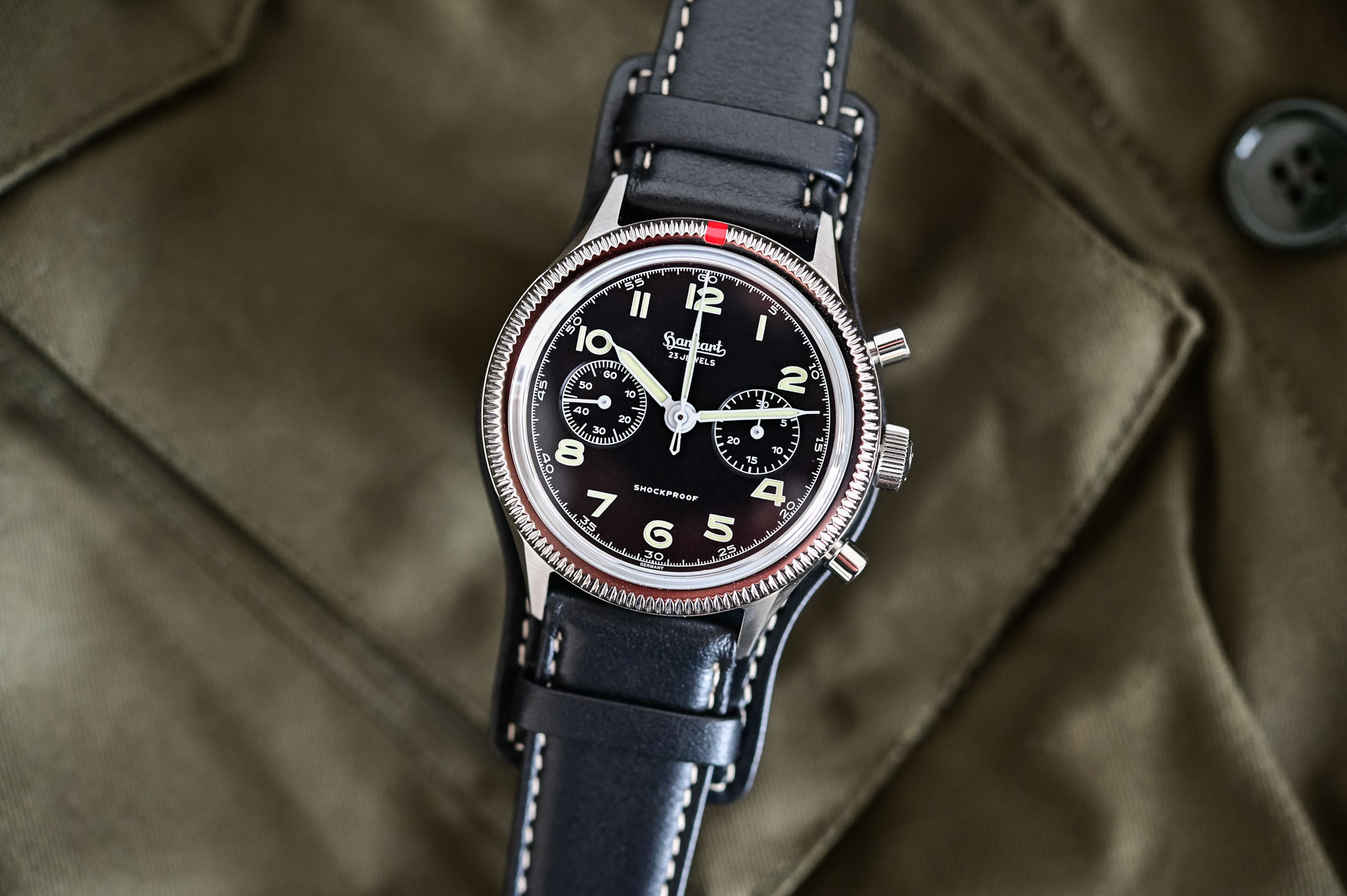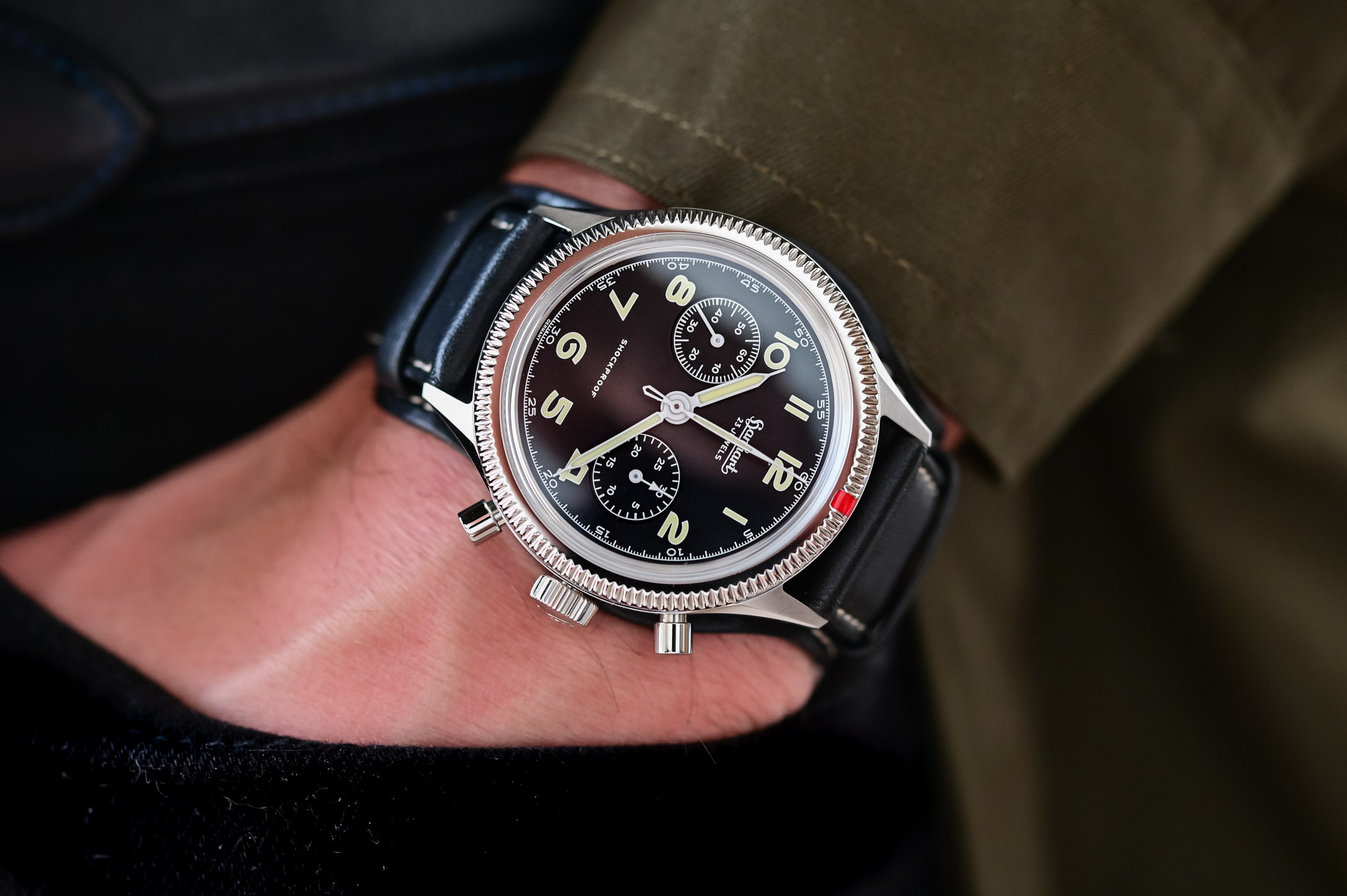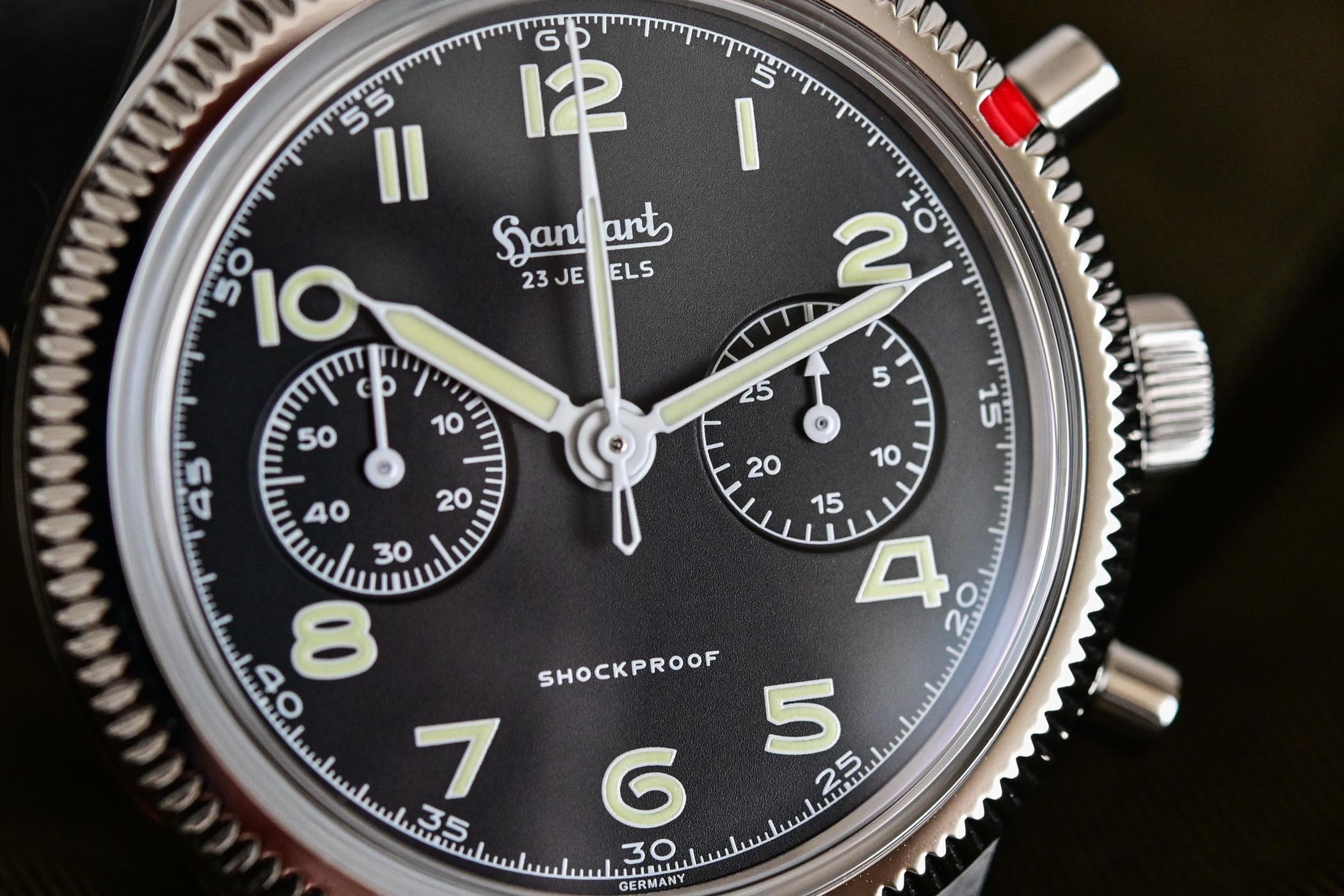The Hanhart 417 ES Reissue Pilot’s Chronograph (Live Pics & Price)
The first pilot’s chronograph for the German armed forces, now re-edited.

When discussing pilot chronographs, one can’t overlook German manufactures, especially Hanhart, which has specialised in this field for several decades. Among the multiple timepieces created by the brand, such as the TachyTele Pilot’s Chronograph, one holds a special place in the brand’s portfolio, for two reasons. One, it was the first pilot’s chronograph for the German armed forces. This watch is the Hanhart 417 ES, and today, it’s back in a slightly modernized, ultra-cool re-edition with an accessible price.
A Chronograph for the German armed forces
Although manufacturing takes place in Germany, Hanhart was initially founded in Diessenhofen, Switzerland by watchmaker Johann A. Hanhart in 1882. The manufactory relocated to Schwenningen in southern Germany in 1902 and in 1924 Hanhart introduced its first stopwatch. The brand quickly specialised in this field, and by the time Europe entered the war, Hanhart started to deliver purpose-built wrist chronographs for military forces. The first Hanhart chronograph launched in 1938 and was powered by the company’s in-house, single-pusher calibre 40. The model quickly became popular with both German pilots and naval officers during the war. A year later, the TachyTele pilot’s chronograph launched with the new calibre 41, a double-pusher flyback movement.

In the mid-1950s, Hanhart built the first pilot’s chronograph for the German armed forces based on three criteria: robustness, reliability and readability. The result of these requirements gave birth to the watch known as the 417, available in chrome-plated brass (417) and stainless steel (417 ES, for Edelstahl, German for stainless steel). Hanhart supplied the German armed forces with this chronograph – so-called Bundeswehrchronograph – for almost ten years until the brand concentrated on building hand stopwatches in 1963.
The original Hanhart 417 ES, a watch measuring 39mm in diameter, had all the classic attributes of Flieger chronographs and Hanhart stopwatches, with the signature continuously rotatable fluted bezel with a red marking. A noticeable evolution compared to the WWII-era timepieces is that the 417 ES was equipped with pencil-shaped hands in place of cathedral hands. These were powered by the brand’s in-house calibre 42, a hand-wound flyback column-wheel, two-pusher chronograph movement with 17 jewels. It is believed that around 1,000 examples were made, with only half of them being ES models.
The Hanhart 417 ES Reissue
Fast-forward to 2020. Hanhart is still operating and still produces watches that perfectly match the original brand concepts of reliability, durability and heavy pilot-watch inspiration. Hanhart has several collections in its range, from very cool dashboard counters for racing and classic cars to bold and instrumental aviation watches – like the Primus. Still, the most emblematic collection remains the Pioneer, watches that pay tribute to military pilot’s watches of the mid-20th century, mostly with traditional chronographs designed for seasoned collectors.
And this is the airspace of the Hanhart 417 ES Reissue. The idea behind this watch was to bring back the legendary bi-compax chronograph of the German armed forces in a slightly modernized version, at a relatively accessible price so that enthusiasts could enjoy it.
Starting with the case and the design, the watch looks and feels almost identical to the original 417 ES, of course without the patina and the signs of time. The case is made of stainless steel and has grown to a 42mm diameter – instead of the 39mm of the original watch. The height of the watch remains under control, however, with a 13.3mm thickness that includes a thick, domed sapphire crystal. The latter offers nice reflections and a cool retro vibe to this vintage-oriented chronograph. Another positive feature is that the lugs are rather short and well designed, so the watch appears quite compact on the wrist.
On the matter of finishing and quality, I was impressed by the solidity and precision of the assembly of the case. All the parts feel perfectly aligned and neatly assembled, with a pleasant feeling of robustness. The case is also nicely executed, with polished and brushed surfaces, including a nice polished bevel on the sides of the lugs. The transition between the different surfaces is also precise and neatly executed.
Just like the original, the Hanhart 417 ES Reissue is a two-pusher chronograph, equipped with the signature fluted bezel with the red marking. The bezel rotates continuously, in both directions, without clicks. It is smooth to operate and firm enough at the same time, so no risk of accidentally changing the position of the bezel when wearing it. The caseback is solid stainless steel and engraved with the brand’s historic logo. The watch is water-resistant to 100m, a very comfortable rating for a pilot’s chronograph.
To keep the look as close to the historical model as possible, the 417 ES Reissue is worn on a black calfskin strap (21mm between lugs) with an additional leather underlay, a style that is known as a “Bund” strap. While this certainly adds to the thickness of the watch and its presence on the wrist, it really contributes to the overall coolness of this piece, and I wouldn’t wear it any differently – even though you can, of course, remove the lower leather piece and wear it on a classic 2-piece strap. The strap features Alcantara on the inside surface, making it very soft on the skin. It is closed by a steel pin buckle.
Moving on to the dial, Hanhart has also paid great attention to the details and has tried to bring back most of the original spirit in a modernized package. First, the 417 ES Reissue Pilot’s Chronograph retains the classic bi-compax (and no-date) layout of the original watch. Then, all the elements, including the logo, the Arabic numerals, the different tracks – whether on the dial itself or the sub-counters – the numbers of jewels or the shockproof mention have been reproduced in a faithful way, giving this model its own identity in the collection.
While the position of the sub-dials has evolved – due to the contemporary movement and the slightly larger diameter – their new position feels actually more balanced. Hanhart has also maintained the typical pencil-shaped hands as well as the arrow hand of the 30-minute counter. The dial is treated in matte black with a fine-grained texture, avoiding undesired reflections. The Arabic hour numerals and the three central hands are filled with beige Super-LumiNova – it’s worth pointing out that the colour hasn’t been exaggerated and it has enough charm without falling into a vintage gimmick. Altogether, the dial is spot-on – faithful, warm, relevant, full of charm and very neatly executed… Special mention for the minute hand, bent at the tip to follow the curvature of the crystal.
The main evolution concerns the movement. Of course, the calibre 42 isn’t produced anymore and we don’t expect it to be back. Considering the usual price range of Hanhart, this wouldn’t make sense. Thus, in order to keep this 417 ES Reissue within a reasonable price range, Hanhart relies on Sellita and its SW 510 (a movement based on the Valjoux architecture), here used in a hand-wound version, for both historical relevance and thinness. This movement is known to be reliable and precise, and both the crown and pushers operate smoothly. The power reserve of this 4Hz cam-lever movement is also comfortable, with a minimum of 58 hours when fully wound.
Thoughts
As you might have guessed from this article, I’ve been genuinely impressed and pleased by the Hanhart 417 ES Reissue. First of all, if not 100% accurate, the re-edition is very close to the original, and the charm of the vintage model is undeniably present. The watch is full of nice details, such as the fonts, numerals and historical logos, and everything is well dosed, not overly done as is sometimes the case of vintage re-editions.
Also, the overall quality is pretty impressive regarding the price. The watch feels solid as a rock and refined at the same time. Coming in at under EUR 2K, the price is more than justified for a hand-wound chronograph. This might not be very objective, but yes, I have a crush on this watch…
Availability & Price
The Hanhart 417 ES Reissue Pilot’s Chronograph will be released as part of the permanent collection and won’t be limited in production. It will be priced at EUR 1,744.87 (with 16% German VAT). The coming year, after the adjustment to 19% value-added tax, the price will be EUR 1,790.
In both cases, a fair price for what is an iconic German watch, with great built quality, history and style. It is now available for orders at www.hanhart.com.


















7 responses
The lugs should have 22mm not 21, other than that, the dial should have been 39 mm or even a bit smaller. In the end, not a bad job and thanks to Hanhart for not making this an LE !
I ever so slightly prefer the Junghans Meister Pilot over this. Hanhart nonetheless, has a winner here.
Amazing job! It is a stunner and a modern interpretation of an iconic watch. Not 100% perfect but nevertheless a must-have piece!
I have the bronze version of this watch. The revolution limited edition. I love it! My go to watch at the moment. The strap is so soft and the lume is great. I love the fact it’s hand wound and no date. For the price, a no brainer.
Does anyone know of a smaller version of this style watch and preferably with a thin coin edge bezel ( picky right?) also lower price while i’m at it ! lol Used is fine.
How much would I have loved this watch if it would be 39mm diameter. Like Breitling or Glycine have done with their Navitimer/Airman re-issues. Please just keep the original dimensions next time :-/
The best looking Hanhart watch. Stunning!